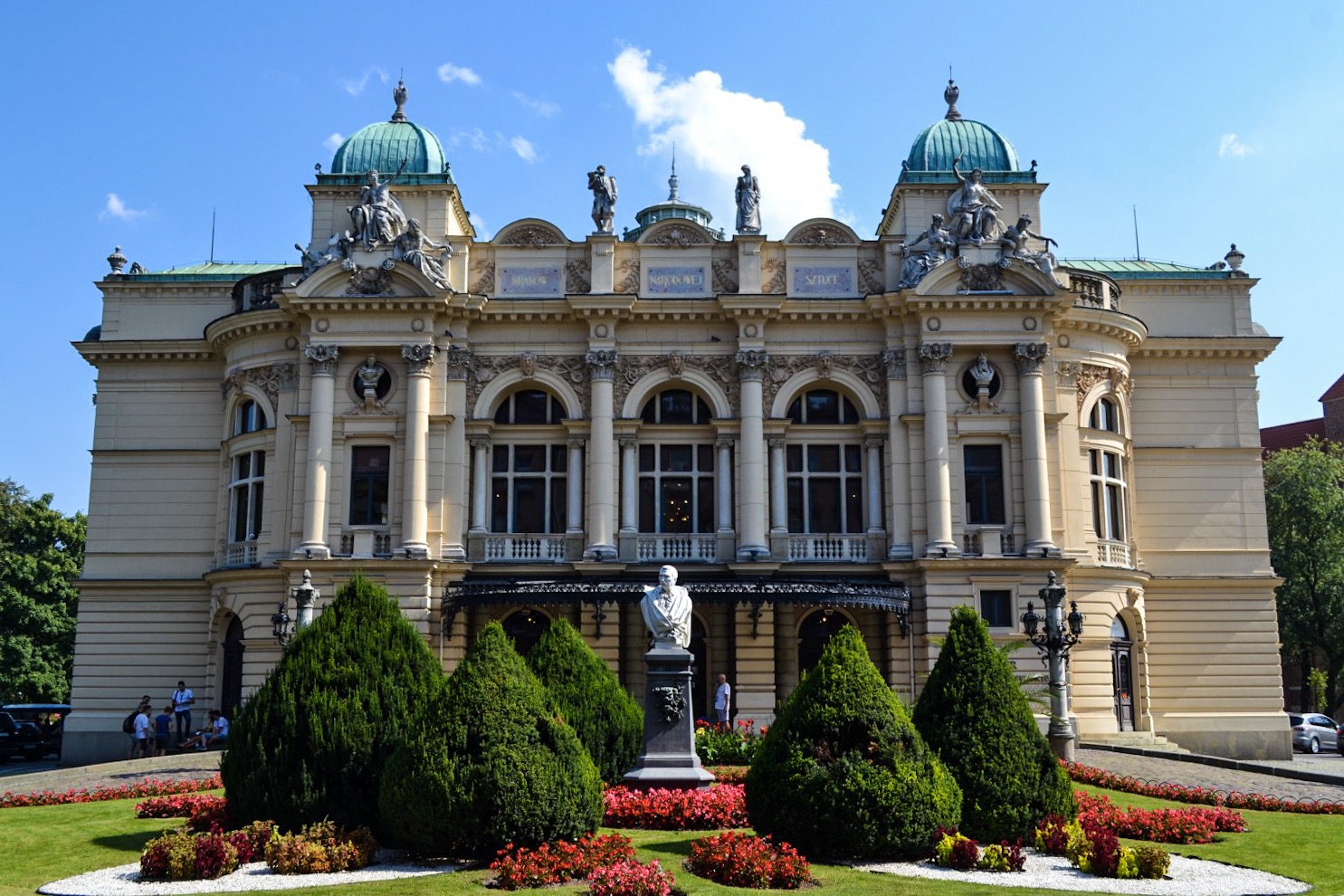The Słowacki Theatre

The Słowacki Theater
The Juliusz Słowacki Theatre in Krakow (Polish: Teatr im. Juliusza Słowackiego w Krakowie), built between 1891-1893 on Holy Ghost Square in place of the former Holy Ghost Church, ranks among the most precious relics of a theatre architecture in Europe.
The building, designed by Jan Zawiejski, is maintained in an eclectic style with the emphasis on Neo-Baroque. This 19th-century theatre-opera house was the first construction in Krakow, where electric lighting was installed. Originally, the theatre was called Municipal Theatre (Teatr Miejski) and only in 1909 it was named after Polish poet Juliusz Słowacki. The main facade is decorated with an inscription: Kraków Narodowej Sztuce - which means - Krakow For the National Arts. The interiors of the building are painted with frescoes by the Viennese artist Anton Tuch and embellished with a splendid curtain by Henryk Siemiradzki. The official opening of the new theatre was held on October 21, 1893 at midday and from that moment this place has been operating continuously. At the first spectacle, fragments of Mickiewicz, Słowacki and Fredro were presented. During the next five weeks only Polish repertoire was staged.
The choice of location for the Słowacki Theatre was not without heated arguments. Finally, after many disputes, the Holy Ghost Square was chosen, which resulted in demolishing of many historic buildings. The Holy Ghost Church and other architectural landmarks of this area were strongly defended by Jan Matejko himself. When his protests appeared to be fruitless, the artist renounced the honorary citizenship of Krakow city and forbade to exhibit his paintings in Krakow.
At the turn of the 19th and 20th centuries, the Juliusz Słowacki Theatre was at its boom times. It was none other than Polish national playwright Stanisław Wyspiański who determined the unique position of this place. This great artist blessed with genius for poetry, painting, as well as stage designing, presented at the Municipal Theatre the majority of his works. The premiere of his 'Wesele' ('The Wedding') on 16 March 1901 is one of the most significant events in the history of Polish culture. In the interwar period, Słowacki Theatre managed to keep its high position, despite being among the greatest theatres of independent Poland such as these of Warsaw, Lviv and Vilnius. In 1921 the most prominent representative of Polish Avant-Garde of 20th century – Stanisław Ignacy Witkiewicz (Witkacy) - made his debut here. The premiere of his grotesque and full of absurd drama 'Tumor Mózgowicz' resulted in few compliments and the wave of criticism. Just before the outbreak of the World War II, Słowacki Theatre paid its respects to the free Fatherland with a patriotic spectacle of A Hymn to Polish Arms by L.H. Morstin, performed in the Wawel courtyard. After the war started in the autumn of 1939, the staff of the theatre was soon forced to leave the edifice. For the following five years the building housed a German theatre which was the object of Hitler's propaganda. The theatre reopened for Polish audience in February 1945. In 1980, shortly after the Polish Pope Jan Paweł II was elected for the Holy See, the Słowacki Theatre staged the world premiere of Karol Wojtyła's drama 'Our God's Brother' ('Brat naszego Boga'), which attracted great interest.
The Juliusz Słowacki Theatre in Krakow is recognized also as 'Krakow Salon' which gathers all honourable celebrants on occasions of anniversary parties of scholars and artists from different countries. What's more, the theatre regularly hosts international and domestic medical conferences. In 2016 Stanisław Wyspiański was chosen a spiritual guardian of this place. Nothing strange about that - it would be difficult to find more suitable patron, whom the theatre owes so much. Wyspiański's idea of searching for deeper meaning, turning back this place, Krakow and the whole Poland from mediocrity and conformity keeps inspiring.
